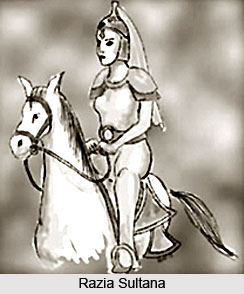 The demise of Iltutmish diluted the political strength in India.After the death of Sultan Iltutmish none of his successors except Razia Sultana deserved to be the Sultan of Delhi. Within ten years after the death of Iltutmish, four Sultans of his dynasty were murdered and the fifth one was a mere puppet in the hands of Balban, who finally finished the rule of the dynasty of Iltutmish and himself occupied the throne. The Turkish slaves took advantage of the weakness of the successors of Iltutmish and captured the sovereign power for themselves.
The demise of Iltutmish diluted the political strength in India.After the death of Sultan Iltutmish none of his successors except Razia Sultana deserved to be the Sultan of Delhi. Within ten years after the death of Iltutmish, four Sultans of his dynasty were murdered and the fifth one was a mere puppet in the hands of Balban, who finally finished the rule of the dynasty of Iltutmish and himself occupied the throne. The Turkish slaves took advantage of the weakness of the successors of Iltutmish and captured the sovereign power for themselves.
Political condition after Iltutmish
The Turkish slave nobles, after the death of Iltutmish, first eliminated the taziqs who could be their contenders for power and then tried to capture the power of the Sultan as well. This resulted in the contest for sovereignty between the Sultan and his Turkish slave nobles. The history of the thirty years of the Delhi Sultanate after the death of Iltutmish remained primarily the history of conflict between the Sultan and the group of forty slave nobles for the sovereign power of the state. Finally Balban was successful in eliminating not only the dynasty of Iltutmish but also rest of the nobles, thereby establishing the rule of a new dynasty.
Weak Successors of Iltutmish
Iltutmish died in 1229 A.D. His next son Firoz Shah, was pleasure loving and irresponsible and thus Iltutmish nominated his daughter Raziya as his successor. After his death, however Firoz succeeded the throne of Delhi but his reign was short lived. He engaged himself in pleasure and entertainment and the cruel and treacherous means of his mother created dissatisfaction among the nobility. Raziya took the advantage of the situation and with the support and from the people of Delhi, she declared herself Sultana of Delhi. Thus the reign of Firoz ended within seven months after his succession. With the accession of Raziya on the throne of Delhi, the struggle for power between the Sultana and the Turkish slave nobles came into open. Raziya was the worthy daughter of a worthy father. After her initial success against the governors, she tried to concentrate power in her own hands and succeeded. Raziya succeeded in bringing about submission of all nobles. During the third year of her reign, trouble started cropping up and the nobles could not tolerate her policy of concentration of power in her own hands. They started conspiring against her with a view to depose her from the throne in which they ultimately succeeded. The accession of Bahram Shah on the throne was the victory of the nobles against Sultana.
Bahram Shah was raised to the throne by the nobles on the condition that he would hand over all the powers of the state in the hands of his "Naibi-i-Mamlakat". Bahram Shah though accepted the powers of the aristocrats but refused to compromise with respect and privileges and, therefore, he too was deposed from the throne and the nobles succeeded in enhancing further their position in the state. Bahram Shah was captured and killed in May 1242 A.D. After him, Ala-ud-din Masud, son of Firoz Shah was placed on the throne.
Accession of Masud Shah
The accession of Masud Shah marked a complete victory for the nobles. The Sultan of Delhi was reduced to being a mere puppet in the hands of the nobles. But it was also made clear that not one among the forty nobles was competent enough to sit on the throne. The mutual jealousy of the aristocrats prevented them to take the throne. Masud Khan was offered the throne on the condition that he would delegate all the powers to the forty and remain Sultan only in name. In 1246 A.D. Masud Shah was deposed and Nasir -ud- din Mahmud, another son of Iltutmish was placed on the throne.
The accession of Nasir -ud -din marked the end of the combat between the Sultan and the Turkish slave nobles. Nasir -ud -din remained only in name and handed over all the powers to Turkish nobles and their leader Balban. Nasir -ud -din was a religious man and had no worldly desires or ambitions. He was simple and kind hearted and avoided the pomp and show usually attached with the office of the Sultan. Nasir -ud -din had got the throne with the help of the nobility and understood well that he could be easily deposed by it. During his reign the power of the state was enjoyed by his "naib", Balban.
Rise of Balban Dynasty
As "naib", Ghiyas-ud- din Balban succeeded only partially in strengthening the Delhi Sultanate. In the year 1265 A.D. Sultan Nasir -ud -din suddenly died and Balban ascended to the throne of Delhi. This established the fact that in the conflict of powers in between the Sultan and the forty Turkish slave nobles, the nobles were victorious at the end as Balban was one of them and became the undisputed Sultan after the death of Nasir -ud -din.



















